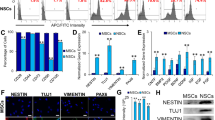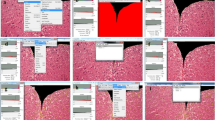Abstract
Introduction
Clinical and experimental studies highlighted the significant therapeutic role of Mesenchymal stem cells (MSCs) in neurodegenerative diseases. MSCs possess potent immunomodulatory properties by releasing exosomes, which generate a suitable microenvironment. microRNAs (miRNAs), as one of several effective bioactive molecules of exosomes, influence cellular communication and activities in recipient cells. Recent studies revealed that miRNAs could control the progression of multiple sclerosis (MS) via differentiation and function of T helper cells (Th).
Methods
Here, we investigated the therapeutic effects of syngeneic-derived BM-MSC in experimental autoimmune encephalomyelitis (EAE) mouse model of MS by evaluating expression profile of miRNAs, pro- and anti-inflammatory in serum and brain tissues. Three-time scheme groups (6th day, 6th & 12th days, and 12th day, of post-EAE induction) were applied to determine the therapeutic effects of intraperitoneally received 1*106 of BM-MSCs.
Results
The expression levels of mature isoforms of miR-193, miR-146a, miR-155, miR-21, and miR-326 showed that BM-MSCs treatment attenuated the EAE clinical score and reduced clinical inflammation as well as demyelination. The improved neurological functional outcome associated with enhanced expression of miR-193 and miR-146a, but decreased expression levels of miR-155, miR-21, and miR-326 were followed by suppressing effects on Th1/Th17 immune responses (reduced levels of IFN-\(\gamma\)and IL-17 cytokine expression) and induction of Treg cells, immunoregulatory responses (increase of IL-10, TGF-β, and IL-4) in treatment groups.
Conclusion
Our findings suggest that BM-MSCs administration might change expression patterns of miRNAs and downstream interactions followed by immune system modulation. However, there is a need to carry out future human clinical trials and complementary experiments.







Similar content being viewed by others
References
Steinman L (2001) Multiple sclerosis: a two-stage disease. Nat Immunol 2(9):762–764
Lazibat I, Rubinić-Majdak M, Županić S (2018) Multiple sclerosis: new aspects of immunopathogenesis. Acta Clin Croatica 57(2):352
Constantinescu CS, Farooqi N, O’Brien K, Gran B (2011) Experimental autoimmune encephalomyelitis (EAE) as a model for multiple sclerosis (MS). Br J Pharmacol 164(4):1079–1106
Kallaur AP, Oliveira SR, Simão ANC et al (2017) Cytokine profile in patients with progressive multiple sclerosis and its association with disease progression and disability. Mol Neurobiol 54:2950–2960
Gharibi S, Moghimi B, Haghmorad D et al (2019) Altered expression patterns of complement factor H and miR-146a genes in acute‐chronic phases in experimental autoimmune encephalomyelitis mouse. J Cell Physiol 234(11):19842–19851
Xie Z-X, Zhang H-L, Wu X-J, Zhu J, Ma D-H, Jin T (2015) Role of the immunogenic and tolerogenic subsets of dendritic cells in multiple sclerosis. Mediators of inflammation. ;2015
Fletcher JM, Lalor S, Sweeney C, Tubridy N, Mills K (2010) T cells in multiple sclerosis and experimental autoimmune encephalomyelitis. Clin Experimental Immunol 162(1):1–11
Ghannam S, Bouffi C, Djouad F, Jorgensen C, Noël D (2010) Immunosuppression by mesenchymal stem cells: mechanisms and clinical applications. Stem Cell Res Ther 1(1):2
Wang X, Omar O, Vazirisani F, Thomsen P, Ekstrom K (2018) Mesenchymal stem cell-derived exosomes have altered microRNA profiles and induce osteogenic differentiation depending on the stage of differentiation. 13(2):e0193059. https://doi.org/10.1371/journal.pone.0193059
Cheng L, Zhang K, Wu S, Cui M, Xu T (2017) Focus on mesenchymal stem cell-derived Exosomes: Opportunities and Challenges in Cell-Free Therapy. Stem Cells International 2017:6305295–6305295. https://doi.org/10.1155/2017/6305295
Yu B, Zhang X, Li X (2014) Exosomes derived from mesenchymal stem cells. Int J Mol Sci 15(3):4142–4157
Mathivanan S, Ji H, Simpson RJ (2010) Exosomes: extracellular organelles important in intercellular communication. J Proteom 73(10):1907–1920
Holley CL, Topkara VK (2011) An introduction to small non-coding RNAs: miRNA and snoRNA. Cardiovasc Drugs Ther 25(2):151–159
Yang X, Wu Y, Zhang B, Ni B (2018) Noncoding RNAs in multiple sclerosis. Clin Epigenetics 10(1):1–12
Mortazavi-Jahromi SS, Aslani M, Mirshafiey A (2020) A comprehensive review on miR-146a molecular mechanisms in a wide spectrum of immune and non-immune inflammatory diseases. Immunol Lett.
Moore C, Kennedy T, Antel J, Bar-Or A, Dhaunchak A (2013) MicroRNA dysregulation in multiple sclerosis. Front Genet 3:311
Gandhi R, Healy B, Gholipour T et al (2013) Circulating microRNAs as biomarkers for disease staging in multiple sclerosis. Ann Neurol 73(6):729–740
Gharibi S, Moghimi B, Tahoori MT, Mahmudi MB, Shahvazian E, Yazd EF (2018) The mMiR-223: an inflammatory MicroRNA involved in pathogenesis of multiple sclerosis. Int J Med Lab.
Liu C, Yang H, Shi W, Wang T, Ruan Q (2018) Micro RNA-mediated regulation of T helper type 17/regulatory T‐cell balance in autoimmune disease. Immunology 155(4):427–434
Fenoglio C, Ridolfi E, Galimberti D, Scarpini E (2012) MicroRNAs as active players in the pathogenesis of multiple sclerosis. Int J Mol Sci 13(10):13227–13239
Orefice NS, Guillemot-Legris O, Capasso R et al (2020) miRNA profile is altered in a modified EAE mouse model of multiple sclerosis featuring cortical lesions. Elife 9:e56916
Zhu S, Pan W, Qian Y (2013) MicroRNA in immunity and autoimmunity. J Mol Med 91(9):1039–1050
Maciak K, Dziedzic A, Miller E, Saluk-Bijak J (2021) miR-155 as an important Regulator of multiple sclerosis pathogenesis. A review. Int J Mol Sci 22(9):4332
Angelou CC, Wells AC, Vijayaraghavan J et al (2020) Differentiation of pathogenic Th17 cells is negatively regulated by Let-7 microRNAs in a mouse model of multiple sclerosis. Front Immunol 10:3125
Shahla J, Dariush H, Bijan SM, Majid E, Zahra A, Bahman Y (2021) Comparative immunomodulatory effects of jelly royal and 10-H2DA on experimental autoimmune encephalomyelitis. Gene Rep. :101217
Soltanmohammadi A, Tavaf MJ, Zargarani S et al (2022) Daphnetin alleviates experimental autoimmune encephalomyelitis by suppressing Th1 and Th17 cells and upregulating Th2 and regulatory T cells. Acta Neurobiol Exp 82(3):273–283. https://doi.org/10.55782/ane-2022-026
Haghmorad D, Yazdanpanah E, Sadighimoghaddam B et al (2021) Kombucha ameliorates experimental autoimmune encephalomyelitis through activation of Treg and Th2 cells. Acta Neurol Belgica Dec 121(6):1685–1692. https://doi.org/10.1007/s13760-020-01475-3
Haghmorad D, Yazdanpanah E, Jadid Tavaf M et al Prevention and treatment of experimental autoimmune encephalomyelitis induced mice with 1, 25-dihydroxyvitamin D3. Neurological research. Aug 12 2019:1–15. https://doi.org/10.1080/01616412.2019.1650218
Berard JL, Wolak K, Fournier S, David S (2010) Characterization of relapsing-remitting and chronic forms of experimental autoimmune encephalomyelitis in C57BL/6 mice. Glia Mar 58(4):434–445. https://doi.org/10.1002/glia.20935
Warth SC, Hoefig KP, Hiekel A et al (2015) Induced miR-99a expression represses Mtor cooperatively with miR‐150 to promote regulatory T‐cell differentiation. EMBO J 34(9):1195–1213
Rawat S, Gupta S, Mohanty S (2019) Mesenchymal stem cells modulate the immune system in developing therapeutic interventions. Immune Response Act Immunomodul.
Yousefi F, Ebtekar M, Soudi S, Soleimani M, Hashemi SM (2016) In vivo immunomodulatory effects of adipose-derived mesenchymal stem cells conditioned medium in experimental autoimmune encephalomyelitis. Immunol Lett Apr 172:94–105. https://doi.org/10.1016/j.imlet.2016.02.016
Sugaya K, Vaidya M (2018) Stem cell therapies for neurodegenerative diseases. Exosomes Stem Cells and MicroRNA: Aging Cancer and Age Related Disorders. :61–84
Saldaña L, Bensiamar F, Vallés G, Mancebo FJ, García-Rey E, Vilaboa N (2019) Immunoregulatory potential of mesenchymal stem cells following activation by macrophage-derived soluble factors. Stem Cell Res Ther 10(1):1–15
Bassi ÊJ, de Almeida DC, Moraes-Vieira PMM, Câmara NOS (2012) Exploring the role of soluble factors associated with immune regulatory properties of mesenchymal stem cells. Stem Cell Reviews and Reports 8(2):329–342
Toh WS, Zhang B, Lai RC, Lim SK (2018) Immune regulatory targets of mesenchymal stromal cell exosomes/small extracellular vesicles in tissue regeneration. Cytotherapy 20(12):1419–1426
Podshivalova K, Salomon DR (2013) MicroRNA regulation of T-lymphocyte immunity: modulation of molecular networks responsible for T-cell activation, differentiation, and development. Crit Reviews™ Immunol. ;33(5)
Ulivieri C, Baldari CT (2017) Regulation of T cell activation and differentiation by extracellular vesicles and their pathogenic role in systemic lupus erythematosus and multiple sclerosis. Molecules 22(2):225
Fernández-Messina L, Gutiérrez‐Vázquez C, Rivas‐García E, Sánchez‐Madrid F, de la Fuente H (2015) Immunomodulatory role of microRNAs transferred by extracellular vesicles. Biol Cell 107(3):61–77
Garcia G, Pinto S, Cunha M, Fernandes A, Koistinaho J, Brites D (2021) Neuronal dynamics and mirna signaling differ between sh-sy5y appswe and psen1 mutant ipsc-derived ad models upon modulation with mir-124 mimic and inhibitor. Cells 10(9):2424
Dobrowolny G, Martone J, Lepore E et al (2021) A longitudinal study defined circulating microRNAs as reliable biomarkers for disease prognosis and progression in ALS human patients. Cell Death Discovery 7(1):1–11
He S, Huang L, Shao C et al (2021) Several miRNAs derived from serum extracellular vesicles are potential biomarkers for early diagnosis and progression of Parkinson’s disease. Translational Neurodegeneration 10(1):1–12
Chen C, Zhou Y, Wang J, Yan Y, Peng L, Qiu W (2018) Dysregulated MicroRNA involvement in multiple sclerosis by induction of T helper 17 cell differentiation. Front Immunol 9:1256
Mathieu J, Ruohola-Baker H (2013) Regulation of stem cell populations by microRNAs. Transcriptional and Translational Regulation of Stem Cells. :329–351
Thamilarasan M, Koczan D, Hecker M, Paap B, Zettl UK (2012) MicroRNAs in multiple sclerosis and experimental autoimmune encephalomyelitis. Autoimmun rev 11(3):174–179
Ha T-Y (2011) The role of microRNAs in regulatory T cells and in the immune response. Immune Netw 11(1):11–41
Raphael I, Nalawade S, Eagar TN, Forsthuber TG (2015) T cell subsets and their signature cytokines in autoimmune and inflammatory diseases. Cytokine 74(1):5–17
Zhang J, Zhang ZG, Lu M, Zhang Y, Shang X, Chopp M (2019) MiR-146a promotes oligodendrocyte progenitor cell differentiation and enhances remyelination in a model of experimental autoimmune encephalomyelitis. Neurobiol Dis 125:154–162
Wang C-r, Zhu H-f, Zhu Y (2019) Knockout of microRNA-155 ameliorates the Th17/Th9 immune response and promotes wound healing. Curr Med Sci 39(6):954–964
Hu J, Huang C-X, Rao P-P et al (2019) Inhibition of microRNA-155 attenuates sympathetic neural remodeling following myocardial infarction via reducing M1 macrophage polarization and inflammatory responses in mice. Eur J Pharmacol 851:122–132
Du C, Liu C, Kang J et al (2009) MicroRNA miR-326 regulates TH-17 differentiation and is associated with the pathogenesis of multiple sclerosis. Nat Immunol 10(12):1252–1259
Amici SA, Dong J, Guerau-de-Arellano M (2017) Molecular mechanisms modulating the phenotype of macrophages and microglia. Front Immunol 8:1520
Funding
This research was funded by grant no. 1587 from Semnan University of Medical Sciences (SEMUMS) research council.
Author information
Authors and Affiliations
Contributions
All authors contributed to the study conception and design. BY and DH methodology; A. K. software; A. S. validation; M. E. M. T. and M. D. formal analysis; (A) K. investigation; M. T writing-original draft preparation; V. O. writing-review and editing, DH; (B) Y. project administration. All authors have read and agreed to the final version of the manuscript.
Corresponding author
Ethics declarations
Ethics approval and consent to participate
All experiments were carried out in agreement with protocols approved by the ethics committee of Semnan University of Medical Sciences in Semnan, Iran (IRCT: IR.SEMUMS.REC.1398.46, ID: 1587).
Conflict of interest
All authors declare no financial or commercial conflict of interest; none have any non-financial conflict of interest.
DOI and license of Preprint
Posted Date: January 25th, 2022 DOI: https://doi.org/10.21203/rs.3.rs-1260157/v1 License: This work is licensed under a Creative Commons Attribution 4.0 International License. Read Full License.
Additional information
Publisher’s Note
Springer Nature remains neutral with regard to jurisdictional claims in published maps and institutional affiliations.
Rights and permissions
Springer Nature or its licensor (e.g. a society or other partner) holds exclusive rights to this article under a publishing agreement with the author(s) or other rightsholder(s); author self-archiving of the accepted manuscript version of this article is solely governed by the terms of such publishing agreement and applicable law.
About this article
Cite this article
Haghmorad, D., Khaleghian, A., Eslami, M. et al. Bone marrow mesenchymal stem cells to ameliorate experimental autoimmune encephalomyelitis via modifying expression patterns of miRNAs. Mol Biol Rep 50, 9971–9984 (2023). https://doi.org/10.1007/s11033-023-08843-1
Received:
Accepted:
Published:
Issue Date:
DOI: https://doi.org/10.1007/s11033-023-08843-1




